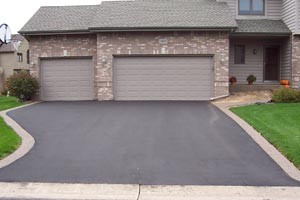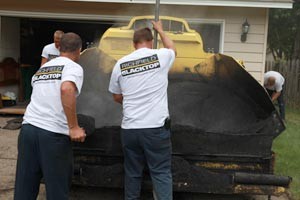For most Twin Cities property owners, understanding how things work is important before they make decisions about their driveways. Asphalt driveway construction is not a common job for most people and it is fairly easy to get confused about all the paving options. Since a driveway is a big investment in your property, we want to make sure you make the best decision that fits your needs and budget. We’ve created this guide to the issues involved with asphalt driveway paving and construction. It will help you understand the issues and solutions that will give you a long-lasting, beautiful driveway that will enhance the enjoyment of your home, while adding value. Here are the essential things you need to know when making a decision:

Your Driveway’s Foundation – A Crucial Part of Every Driveway
The success of any construction project begins with the foundation, and building a new driveway is no exception. If the foundation – the sub-base below the asphalt – is not built correctly you’re bound to have problems in the future. This sub-base is the true foundation for your driveway has two primary jobs:
- It provides a stable surface to support the pavement
- It provides a frost barrier to help reduce winter damage due to freezing and thawing.
 Much depends, when designing a sub-base for your driveway, on the particular soil conditions at your site. In some areas, a well-drained, sandy soil can act as its own sub-base without modification. In other areas, where clay soils or other poorly compacted soils exist, a brand new sub-base must be laid. Where there is an existing driveway, a poorly designed or contaminated sub-base may have to be completely removed and replaced. No single solution will work in every case.
Much depends, when designing a sub-base for your driveway, on the particular soil conditions at your site. In some areas, a well-drained, sandy soil can act as its own sub-base without modification. In other areas, where clay soils or other poorly compacted soils exist, a brand new sub-base must be laid. Where there is an existing driveway, a poorly designed or contaminated sub-base may have to be completely removed and replaced. No single solution will work in every case.
The main issues that need to be addressed when preparing the base for paving are; the sub-grade, drainage, base thickness, base stability, dimensions and compaction. The minimum thickness of the sub-base should typically be 4 inches. The thickness of the base will be determined by what the driveway will be used for. If it’s a typical driveway and normal sized cars or SUV’s will be driving on it, 4-6 inches of base is adequate. For heavy equipment, trailers or trucks, and in some special situations, a deeper base is recommended.
A properly compacted base is crucial. The best type of base is class 5 limestone or recycled class 5 made out of concrete bituminous (con-bit). These bases are highly compactable and strong. A vibratory drum roller should be used versus a static roller to compact the base. It will create the greatest compaction density because the vibrating action of the roller will cause the base material to be compacted from the bottom up. A vibratory plate compactor will be used in areas not accessible by the rollers.
The surface of the compacted base should be smooth, with a maximum tolerance of plus or minus 3/8 inch over a 10 ft straight edge. And finally, the base must be firm and ready before paving. On occasion, especially if the base is 6 inches or more, additional time may be needed to let the base firm up.
Drainage – Where’s The Water Going to Go?
 The paving contractor should develop a drainage plan for your driveway. Each driveway is different. Some driveways have a nice slope from the garage to the street. In these cases the drainage plan is simple – run the water to the street. But some driveways have a negative drainage, where the elevation is higher at the street than the garage. In these cases a swale is needed in front of the garage to run the water off to the side of the driveway – preventing water from entering the garage.
The paving contractor should develop a drainage plan for your driveway. Each driveway is different. Some driveways have a nice slope from the garage to the street. In these cases the drainage plan is simple – run the water to the street. But some driveways have a negative drainage, where the elevation is higher at the street than the garage. In these cases a swale is needed in front of the garage to run the water off to the side of the driveway – preventing water from entering the garage.
Some driveways, especially those with detached garages need a drainage plan that runs the water away from the house, into the yard – and when possible, down to the street. Some drainage plans are even more complex. In every case, careful design and construction is required to properly handle drainage from your driveway. Discuss these drainage issues with your driveway contractor before any work begins. At Richfield Blacktop, we’ve solved the most complex drainage problems in our 60+ years of building driveways.
What Is Hot Mix Asphalt?
 The hot mix asphalt for your driveway is an engineered mixture of stones, sand, and a petroleum product called liquid asphalt cement. Varying sizes of this stone and sand mixture, called aggregate, are heated and then mixed in exact proportions with liquid asphalt cement that is heated to 300 degrees.
The hot mix asphalt for your driveway is an engineered mixture of stones, sand, and a petroleum product called liquid asphalt cement. Varying sizes of this stone and sand mixture, called aggregate, are heated and then mixed in exact proportions with liquid asphalt cement that is heated to 300 degrees.
While the mixture is hot, it is delivered to your driveway and applied on top of the prepared sub-base with a self-propelled paving machine. By using a paving machine, the asphalt is applied at a consistent, even thickness, creating a smooth, even, attractive paved surface. Richfield Blacktop’s paving machines will do a great job for you.
The asphalt mix hardens quickly and usually can be walked on within one-hour. Depending on weather conditions, you should wait at least 3 days to drive on it. Asphalt cures as it ages. It becomes more flexible and softer the warmer it is. As it ages, it loses some of its oil and becomes less flexible. If you pave during the fall, the curing process stops during the winter, and resumes again in the spring.
The 6 Benefits of Asphalt
- Strength and Durability – That’s why it’s used on so many roads.
- Withstands Freezing & Thawing – Crucial factors in Minnesota.
- Unaffected by Salt – Unlike concrete, asphalt isn’t damaged by salt.
- Flexibility – Asphalt is resistant to winter damage caused by freezes and thaws.
- Cost Effective – Asphalt is economical, compared to other paving materials.
- Melts Snow Fast – The black color melts snow, whenever the sun shines.
Can I Simply Put A New Layer Of Asphalt Over My Old One?
In some cases it is possible to overlay an existing asphalt driveway with another layer of asphalt. This can save money over a full driveway replacement. This is infrequently done, however, for two reasons:
- Anywhere there are existing cracks or where the asphalt is broken up will “reflect” through the new layer.
- Drainage may be disturbed. Adding a layer of asphalt raises the height of the driveway. Unless your driveway has sunk in front of the garage or street, the new layer will be higher and can present drainage problems. We can solve these problems by milling out problem areas, but for smaller driveways, complete replacement is usually the best choice overall. Fewer than 5% of our customers choose overlays.
The bottom line is that in some instances an overlay will work. When a professional driveway consultant from Richfield Blacktop visits, they will evaluate your driveway completely and make recommendations about your paving options. You can rely on their advice for your particular situation.
Asphalt Driveway Maintenance and Care
Every driveway, no matter what materials it uses, requires care and maintenance to insure its long life and beauty. Over time, your driveway may develop cracks or sustain damage, and prompt repairs are needed to prevent further damage. Proper sealing is important, too, on a periodic basis. You can learn more about driveway care and maintenance on our website.
Richfield Blacktop – Twin Cities Driveway & Paving Leader
At Richfield Blacktop, educating our customers is an important part of our legendary customer service. The more our customers know, the better able they are to make the best decisions about their driveway. Since 1954, we’ve been helping our customers make the right decisions for their property. We want every driveway we build to provide beauty and service for a long time to come. Contact us today to schedule a visit from one of our expert driveway consultants. He’ll answer all of your questions and help you choose the right materials and construction techniques for your exact location. Every driveway and property is unique, and Richfield Blacktop’s long experience and highly trained driveway consultants are your assurance of a great driveway for your home or commercial property.




